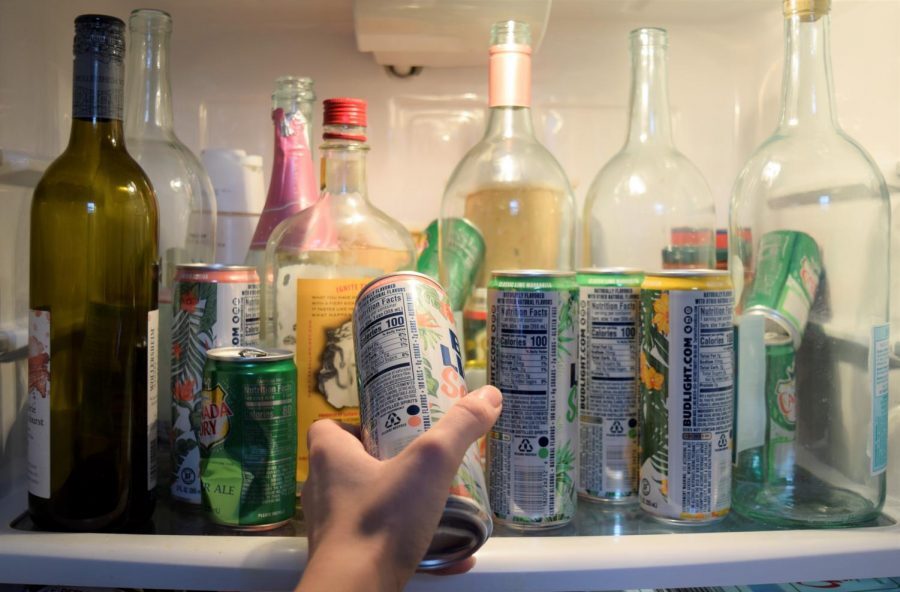‘I’ve had a lot of fun without it’: Dry January encourages sober life at Pitt
A student places a can of alcoholic seltzer into a fridge.
January 26, 2023
Meg Anderson is considering never drinking again — even after Dry January ends.
“I think for me, I’m considering not drinking at all again after this because I feel really good,” Anderson, a senior finance and information systems major, said. “I’m saving money and I’ve had a lot of fun without it.”
While alcohol consumption is fairly regular on college campuses, some students will remain sober this month to partake in Dry January, an initiative that invites participants to abstain from alcohol. The National Institute of Alcohol Abuse and Alcoholism says around 53% of full-time college students drank alcohol in the past month and estimates 33% of students engaged in binge drinking.
Christina Mair, an associate professor in the department of behavioral and community health sciences, said some of the risks associated with alcohol consumption are not widely known.
“Alcohol is related to lots of cancer incidences,” Mair said. “It’s a really strong risk factor for breast cancer and I don’t think a lot of people understand that … For a long time, there was this idea, especially in the 90s, that having a glass of wine was really good for you. First of all, that is not true. Even setting that aside, it still causes cancer.”
According to the National Cancer Institute, alcohol consumption — particularly binge drinking — can lead to higher risks of head and neck, liver and breast cancers. The National Cancer Institute defines binge drinkers as women who consume four or more drinks and men who consume five or more drinks in one sitting.
Mair said lots of people drink the most during their twenties, adding that a “shocking” number of college students could be classified as having an active alcohol use disorder.
“It sort of peaks at that age,” Mair said. “There are these interesting consequences, such as those who go on to develop long-term alcohol use disorders versus those who don’t.”
Anderson said abstaining from alcohol has been a personal discipline test, and it would be easier for students to drink less if fewer weekend activities for college students involved alcohol.
“Even sporting events are usually drinking atmospheres,” Anderson said. “If more people were considered role models on campus or more organizations and student groups pushed events and activities that don’t involve drinking, then maybe people wouldn’t feel as pressured to do it as often.”
Mair also said the heightened availability of alcohol during college could play a role in high alcohol consumption in younger people.
“I remember anecdotally, as a college student, the measures said that four or more drinks were considered binge or heavy drinking,” Mair said. “That’s a lot of alcohol consumption. As an adult, I can’t remember the last time I drank that much, but as a college student, four drinks was just a normal Thursday night.”
According to the National Institute on Alcohol Abuse and Alcoholism, alcohol may encourage violent behavior and aggression. Mair warned about alcohol consumption’s effect on behavior and said alcohol may be involved in nationwide violence on college campuses.
“So there are also lots of behaviors related to either alcohol consumption or places where people drink and socialize,” Mair said. “So much of the sexual violence, sexual assault and partner violence there is on college campuses, alcohol is there in some sort of way.”
Olivia Studnicki, a junior chemistry major and president of Students for Sensible Drug Policy, said she is interested in allocating resources on campus for students struggling with addiction. She said SSDP works to promote educational and rehabilitative policy.
“Combating alcohol use disorder among college students should follow a rehabilitation model where students aren’t punished for misuse, but instead given the help they need,” Studnicki said. “Part of giving students the help they need is helping them feel safe and comfortable enough to recognize when there is a problem, and feeling secure enough to reach out.”
Mair said because she is a social epidemiologist, she often thinks about the politics and social characteristics that lead to the disorder.
“There are genetic predispositions to an alcohol use disorder,” Mair said. “That’s not an unimportant bit, but so much of it is situations, circumstances, and contexts that you are in … For example, childhood traumas and adversity are strongly related to current alcohol consumption as an adult. Those aren’t weaknesses of character. Those are circumstances and life events that have placed you at a higher risk.”








